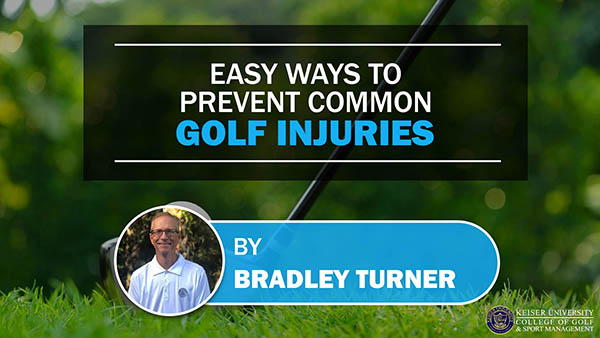Easy Ways to Prevent Common Golf Injuries

By Bradley Turner Keiser University College of Golf Director of Online Golf Instruction – MBA, PGA
As with any activity, if you are injured, it is best to seek the advice of a medical professional. Golf is a sport that should be relaxing and enjoyable. Playing golf with pain is no fun, and if you play too long under the stress of acute pain, your golf swing will subconsciously try to avoid the pain. In short, playing golf when you are in pain is not a good idea.
An 18-hole round of golf takes several hours and can put significant stress on the muscles and joints of the body. Injuries are common for golfers who have not prepared adequately prior to the round. For the avid weekend golfer who tries to play as many holes as possible on a Saturday, too much too soon can keep you on the couch watching golf instead of on the links and playing the game.
Common Injuries
Golfers can experience a wide variety of injuries. One of the most common is back pain, especially in the lower back. Overuse and improper body motion can put undue stress on the lower back. A golf swing should not be painful!
The lead leg (left leg for the right-handed golfer) must support the pressure transfer while rotating the lower body into an athletic post-impact position. For golfers with knee and ankle issues on the lead leg, once again, the brain will try to avoid further pain. Playing golf while trying to avoid pain can significantly change a golf swing. There are numerous stories of professional athletes whose careers ended too early because they tried to play through the pain.
Golfers elbow is tendinitis of the elbow. Tendinitis is debilitating and will keep you off the golf course. Tendinitis is a sign of overuse or fatigued muscles that support the affected tendon. In addition, tendinitis can afflict other parts of the body, including the shoulder, wrist, knees, and feet.
To avoid these maladies mentioned above, you can take a few preventive measures to keep you playing the game.
Pre-Round Warmup
Prior to your round of golf, make it a habit to start with a stretching routine before you hit the first warmup ball on the practice range. If time is short, skipping the stretching step to pound out a few drivers before marching over to the first tee can do more harm than you think. As golfers age, their flexibility becomes a challenge, and it is absolutely in your best interest to get your muscles limbered up before you make a golf swing. The swing you make without stretching will not be the swing you are looking for on the first tee. Your warmup priority should begin with stretching, followed by putting to gauge the green speed, then hitting golf balls on the range. Most amateurs do not follow this warmup priority and, unfortunately, risk injury and poor play.
Relax the Muscles
Tension in the golf swing slows the speed of the swing. Relaxed muscles are fast muscles. A good way to relax the muscles is to keep your grip pressure in check. On a scale of 1 (barely holding the club) to 10 (squeezing it very hard), I advocate a grip pressure from 3 to 4. It is difficult for amateurs to gauge their grip pressure, but most golf instructors agree that a grip pressure of 8-10 is detrimental to a good golf swing. High grip pressure increases tension, and consequently, the possibility of developing tendinitis in the hands, elbows, and shoulders.
Correct Posture
The golf swing is unique as it incorporates a vertical motion as well as a horizontal motion. This allows golfers to hit a ball with power and accuracy. A powerful golf swing is one of the more athletic movements in sports. Make no mistake about the athleticism it takes to hit a golf ball long and straight. Proper posture is essential in allowing the body to flow freely and athletically through the swing. Starting with correct posture is a foundation to playing a healthy game of golf for a lifetime.
To find out more about how to help golfers reach their full potential and explore our golf degree programs, contact the Keiser University College of Golf & Sport Management today at 888-355-4465.















Get a FMS screen to start with.